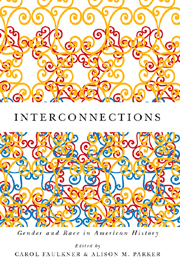Book contents
- Frontmatter
- Contents
- Introduction
- Part 1 Bridging History, Theory, and Practice
- 1 Historicizing Intersectionality as a Critical Lens: Returning to the Work of Anna Julia Cooper
- Part 2 Frontiers of Citizenship
- Part 3 Civil Rights and the Law
- Part 4 Sexuality, Class, and Morality
- Epilogue: Gender and Race as Cultural Barriers to Black Women in Politics
- Selected Bibliography
- List of Contributors
- Index
1 - Historicizing Intersectionality as a Critical Lens: Returning to the Work of Anna Julia Cooper
from Part 1 - Bridging History, Theory, and Practice
Published online by Cambridge University Press: 05 December 2015
- Frontmatter
- Contents
- Introduction
- Part 1 Bridging History, Theory, and Practice
- 1 Historicizing Intersectionality as a Critical Lens: Returning to the Work of Anna Julia Cooper
- Part 2 Frontiers of Citizenship
- Part 3 Civil Rights and the Law
- Part 4 Sexuality, Class, and Morality
- Epilogue: Gender and Race as Cultural Barriers to Black Women in Politics
- Selected Bibliography
- List of Contributors
- Index
Summary
Scholars of intersectionality, historically and presently, start from the premise that both lived identities and structures of power and privilege should be understood as interwoven and not as additive factors or as separable dynamics. Intersectional approaches therefore entail a significant shift in epistemological, ontological, and methodological frames: fundamentally emphasizing simultaneity, scholars of intersectionality employ “tactics, strategies, and identities which historically have appeared to be mutually exclusive under modernist oppositional practices.” Because this alternative mode of reasoning can readily lead to charges of illogic, as Kimberlé Crenshaw has discussed at length, those who employ intersectionality frequently confront being misread or misunderstood.
For example, intersectional models of “both/and” thinking and simultaneity are frequently characterized as too complex or as impossible to engage in, and although intersectionality is widely acknowledged and even lauded as pivotal to feminist studies today, the degree to which the basic premises of intersectionality are understood and its intellectual contexts and history are engaged with and known are highly uneven: it is often interpreted reductively or used acontextually. As Stephanie Shields documents, for instance, “In conventional social and behavioral research, intersectionality frequently becomes redefi ned as a methodological challenge.… [Researchers] have typically responded to the question of intersectionality in one of three ways: excluding the question; deferring the question; limiting the question.” Thus, despite soaring rhetoric suggesting intersectionality is de rigueur in contemporary feminist research, it is too often instrumentalized—as a descriptive or demographic factor, for example, but not employed to develop research questions or to inform theoretical or empirical analyses.
Information
- Type
- Chapter
- Information
- InterconnectionsGender and Race in American History, pp. 17 - 48Publisher: Boydell & BrewerPrint publication year: 2012
